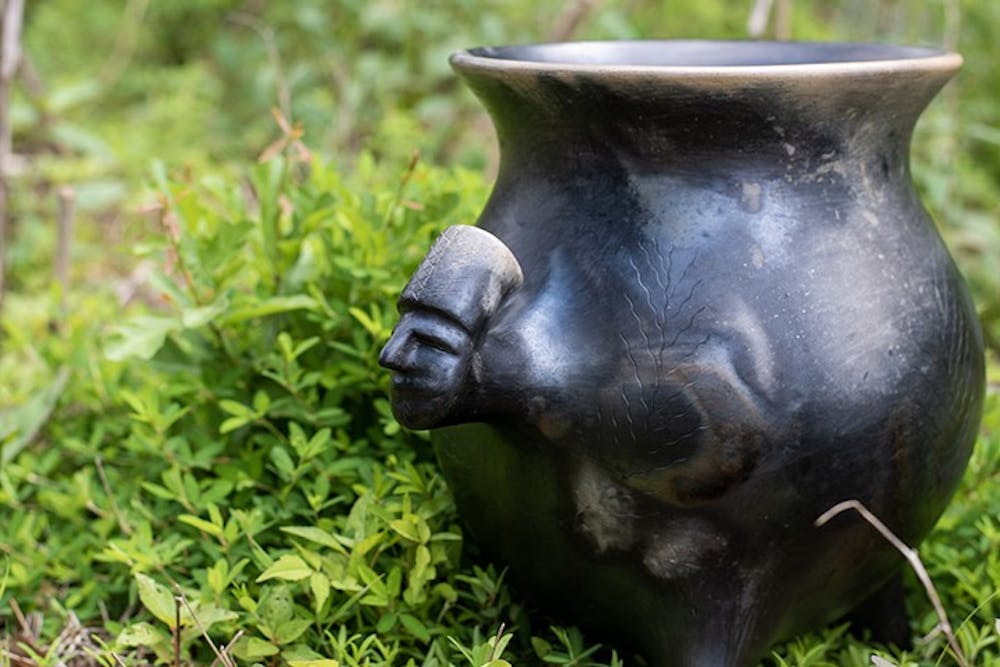Wenonah Haire clearly remembers the first time she tried her hand at traditional Catawba pottery as a child. She said she was excited and proud to “learn about a very important part of [her] heritage.”
The tribe’s pottery tradition has been continuously practiced for 6,000 to 10,000 years — making it the oldest pottery tradition in the U.S. — and its record spans the Southeast. There is no other type of pottery like it in the world: It does not use a pottery wheel, a kiln, paint or glaze as other traditions do.
“It is truly an indigenous art form that is with love and care from the beginning to the end,” said Haire, who is now the executive director of the Catawba Cultural Preservation Project and Tribal Historic Preservation Officer.
The whole process could take upwards of two weeks or longer from the time the potter collects and prepares clay from the banks of the Catawba River to the time they finish hand-shaping the piece, Haire said.
It is always finished by putting it into an open flame. If the piece is improperly prepared, it could explode. Otherwise, various elements of the firing, such as wood type or heat intensity, leave designs and colorings on the ceramic. As Stephen Criswell, the co-director of Native American Studies at USC Lancaster, said, each design is “random chance.”
“At the end, it's all a mystery and a wonder, as one of the elders said,” Haire said. “When you move those cooled ashes away, only then does the beauty of it show.”
In precolonial times, Catawba pottery mainly served a “utilitarian” purpose, though it was always artful. According to Criswell, Catawba pottery served an important economic function to the tribe. Throughout the 19th century, it was illegal for Catawba to work in Rock Hill's textile mills due to their race. As a result, women supplemented their family’s income with pottery to make end’s meet.
For a time, Catawba would sell their pottery outside the gates of Winthrop University — they weren’t allowed on-campus because they weren’t white, Criswell said — for a penny or nickel a piece, according to Haire.
“It was a thing that kept them going and kept them alive and brought in some much needed materials or revenue,” Criswell said.
Another Catawba art form, basket weaving, almost went extinct before its reintroduction to the tribe in the ‘90s through cultural reclamation efforts. Because the necessary longleaf pine needle trees don’t grow very well where the reservation is located near Rock Hill, South Carolina, the tribe has worked with federal and state officials to harvest the needles from other locations.
DeLesslin George-Warren, a consultant who mainly works for the tribe, said there are two expert Catawba basket weavers. Other Catawba, such as Haire, practice it more as a stress-relieving hobby.
Basketry isn’t the only tradition reclamation efforts are reviving. The tribe is reintroducing the language into the community by creating new Catawba songs, George-Warren said. In this way, future generations can have the legacy current generations haven't always gotten.
“I really prickle at the language of like, lost versus taken. I think, a lot of the time, people are more comfortable saying that, ‘They lost this art form,’” George-Warren said. “What's, in my opinion, more accurate, is, it's not like we just dropped it somewhere. It's that it was the incentive structures that we were living in actively disincentivized or punished us if we were practicing those traditions.”
Although it is illegal under the Indian Arts and Crafts Act for non-Native individuals to claim to sell Indigenous art that isn’t, some still do, and some even sell stolen art. Criswell said one tribe member found her son’s after-school project for sale on eBay as “ancient prehistoric Catawba Indian pottery.” The mother bought it back for $60.
“There are predators out in art, taking advantage of Native people,” Haire said. “It’s shameful, but it happens.”
The Catawba Cultural Preservation Program, which runs a craft store, strictly sells Catawba art bought from tribe members and puts the proceeds into classes and programming. You can also buy directly from Catawba artists. Either option ensures your purchase is authentic.
George-Warren said sometimes non-Natives don’t buy Native American artwork, even from Native Americans, out of fear that it is appropriation. If this is the case, he said, then don’t be afraid to ask for clarification.
“If I make a necklace, and I sell it to you, it's ‘cause I want you to wear it,” George-Warren said. “Dive in the door to the arts, and in the process, support us. Don't buy cheap knockoffs.”
The Catawba Indian Craft Store is closed due to the coronavirus and renovations until at least the end of the year, but it remains available online.
Correction Sept. 22, 2020: A previous version of this article incorrectly attributed the photo as being courtesy of The Catawba Indian Nation. The photo is courtesy of the Catawba Nation/Alex Osborn.

